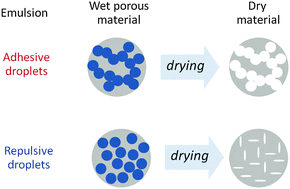Tailoring of the porous structure of soft emulsion-templated polymer materials†
Abstract
This paper discusses the formation of soft porous materials obtained by the polymerization of inverse water-in-silicone (polydimethylsiloxane, PDMS) emulsions. We show that the initial state of the emulsion has a strong impact on the porous structure and properties of the final material. We show that using a surfactant with different solubilities in the emulsion continuous phase (PDMS), it is possible to tune the interaction between emulsion droplets, which leads to materials with either interconnected or isolated pores. These two systems present completely different behavior upon drying, which results in macroporous air-filled materials in the interconnected case and in a collapsed material with low porosity in the second case. Finally, we compare the mechanical and acoustical properties of these two types of bulk polymer monoliths. We also describe the formation of micrometric polymer particles (beads) in these two cases. We show that materials with an interconnected macroporous structure have low mechanical moduli and low sound speed, and are suitable for acoustic applications. The mechanical and acoustical properties of the materials with a collapsed porous structure are similar to those of non-porous silicone, which makes them acoustically inactive.


 Please wait while we load your content...
Please wait while we load your content...